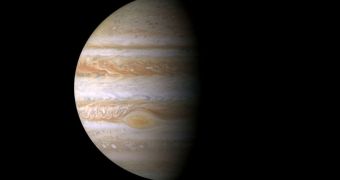Every time you point the telescope towards Jupiter you'll most certainly see one of its four large satellites discovered by Galileo in the early 1600s. Usually, two or three of the moons can be easily spotted and sometimes even all four of them. On a small telescope, Jupiter's moons appear as small stars shinning against the blackness of space, while in other situations they disappear altogether.
Such occasions are very rare and can occur either when all four moons are moving across the disk of the planet - they are in occultation - passing behind Jupiter, or when they are eclipsed by Jupiter's shadow. William Henry Smyth relating the first observation of Jupiter without its satellites - which took place in 1681 - wrote in his book in 1844 that such a conjunction would require more than three thousand billion years before it would occur again.
In reality, a moonless Jupiter can be observed about 20 times in the course of a century. In 1909, Gian Vincenzo Mora, an Italian astronomer, calculated exactly when the moonless Jupiter would occur again throughout the 19th and 20th centuries. Although extremely accurate, the calculations disregarded the years 1859, 1895 and 1962. A similar calculation was conducted by the Belgian astronomical calculator Jean Meeus for the time period between years 1900 to 2100. One of the occasions when Jupiter will appear to have no moon will occur next week.
The event however - taking place on May 21 - will be visible only from the eastern regions of the Unites States and Canada and will last only about 19 minutes. The even will begin at 11:50 p.m. EDT. Io and Callisto will be eclipsed by Jupiter, Europa will be in transit across the planet's disk, while Ganymede will be occulted by Jupiter. The moons will then emerge after 19 minutes, starting with Ganymede which will start to move in front of Jupiter.
Star gazers living in the eastern regions of the American continent would be able to view Jupiter at about 3 to 6 degrees above the east-southeast horizon. The best viewing place will be the Caribbean, where Jupiter will appear in a position about 20 degrees above the horizon. The next such event is expected to take place on September 2-3, 2009 and will again be visible only from the North American continent, only this time the event will take almost two hours.

 14 DAY TRIAL //
14 DAY TRIAL //